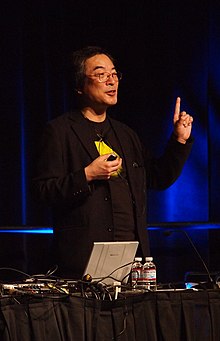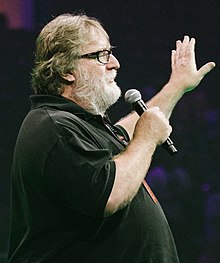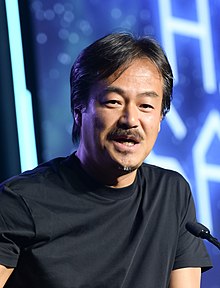Portal:Video games
The Video Games Portal

A video game, also known as a computer game or just a game, is an electronic game that involves interaction with a user interface or input device (such as a joystick, controller, keyboard, or motion sensing device) to generate visual feedback from a display device, most commonly shown in a video format on a television set, computer monitor, flat-panel display or touchscreen on handheld devices, or a virtual reality headset. Most modern video games are audiovisual, with audio complement delivered through speakers or headphones, and sometimes also with other types of sensory feedback (e.g., haptic technology that provides tactile sensations). Some video games also allow microphone and webcam inputs for in-game chatting and livestreaming.
Video games are typically categorized according to their hardware platform, which traditionally includes arcade video games, console games, and computer (PC) games; the latter also encompasses LAN games, online games, and browser games. More recently, the video game industry has expanded onto mobile gaming through mobile devices (such as smartphones and tablet computers), virtual and augmented reality systems, and remote cloud gaming. Video games are also classified into a wide range of genres based on their style of gameplay and target audience. (Full article...)
Featured articles –
Four games were released in the series between 1991 and 1999: the original Seiken Densetsu (1991)—Final Fantasy Adventure in North America and Mystic Quest in Europe—for the Game Boy, Secret of Mana (1993) for the Super Nintendo Entertainment System, Trials of Mana (1995) for the Super Famicom, and Legend of Mana for the PlayStation. A remake of the original game, Sword of Mana (2003), was published for the Game Boy Advance. All of the original games were action role-playing games, though they included a wide variety of gameplay mechanics, and the stories of the games were connected only thematically.
In 2006 and 2007, four more games were released as part of the World of Mana subseries, an attempt by Square Enix to release games in a series over a variety of genres and consoles. These were Children of Mana (2006), an action-oriented dungeon crawler game for the Nintendo DS; Friends of Mana (2006), a Japan-only multiplayer role-playing game for mobile phones; Dawn of Mana (2006), a 3D action-adventure game for the PlayStation 2; and Heroes of Mana (2007), a real-time strategy game for the DS. Children was developed by Nex Entertainment and Heroes by Brownie Brown, founded by several developers of Legend, though Ishii oversaw development of all four games. Three more games have been released since the World of Mana subseries ended: Circle of Mana (2013), a Japan-only card battle game for the GREE mobile platform, Rise of Mana (2014), a Japan-only free-to-play action role-playing game for iOS, Android, and PlayStation Vita, and Adventures of Mana (2016), a 3D remake of Final Fantasy Adventure for the PlayStation Vita, iOS, and Android. In addition to the games, four manga series and one novelization have been released in the Mana franchise. (Full article...)
The story takes place in the year of 2011 when a radical leader has executed the president of an unnamed country in the Middle East, and an ultranationalist movement ignites a civil war in Russia. The conflicts are seen from the perspectives of a U.S. Marine Force Recon sergeant and a British SAS commando and are set in various locales, such as the United Kingdom, the Middle East, Azerbaijan, Russia, and Ukraine. The multiplayer portion of the game features numerous game modes and contains a leveling system that allows the player to unlock additional weapons, weapon attachments, and camouflage schemes as they advance.
The game was praised by critics, especially for its gameplay and storyline, but there was criticism of its lack of innovation. Modern Warfare won numerous "Game of the Year" titles and two BAFTA Video Games Awards. The game is considered one of the greatest video games of all time. It was the top-selling game worldwide in 2007, selling around seven million copies by January 2008 and almost sixteen million by November 2013. It was followed by two sequels that continue the storyline: Call of Duty: Modern Warfare 2 (2009) and Call of Duty: Modern Warfare 3 (2011). (Full article...)
Ocarina of Time was developed by Nintendo's Entertainment Analysis & Development division. It was led by five directors, including Eiji Aonuma and Yoshiaki Koizumi, produced by series co-creator Shigeru Miyamoto, and written by Kensuke Tanabe. Series composer Koji Kondo wrote its soundtrack. The player controls Link in the realm of Hyrule on a quest to stop the evil king Ganondorf by traveling through time and navigating dungeons and an overworld. The game introduced features such as a target-lock system and context-sensitive buttons, which have since become common in 3D adventure games. The player must play songs on an ocarina to progress.
Ocarina of Time was acclaimed by critics and consumers, who praised its visuals, sound, gameplay, soundtrack, and writing. It has been ranked by numerous publications as the greatest video game of all time and is the highest-rated game on the review aggregator Metacritic. It was commercially successful, with more than seven million copies sold worldwide. In the United States, it received more than three times more pre-orders than any other game at the time. A sequel, The Legend of Zelda: Majora's Mask, was released in 2000. Ocarina of Time has been re-released on every one of Nintendo's home consoles and on the iQue Player in China. An enhanced version of the game for the Nintendo 3DS, The Legend of Zelda: Ocarina of Time 3D, was released in 2011. Master Quest, an alternative version of the game including new puzzles and increased difficulty, is included in one of the GameCube releases and the 3D version. (Full article...)
Yacht Club Games envisioned Showdown as a small minigame similar to modes in Mega Man 7 (1995) and Super Mario Bros. 3 (1988). The developers gradually built a more expansive title which they compared to a party game. Showdown was released for Windows, macOS, Linux, PlayStation 3, PlayStation 4, Nintendo Switch, Xbox One, and Wii U on December 10. It was launched alongside the Shovel Knight downloadable content (DLC) campaign King of Cards. The game received average reviews on release, with praise towards its characters and multiplayer gameplay. The single-player mode received a negative response, with many reviewers criticizing its difficulty balancing. (Full article...)
The game takes place on board a starship in a cyberpunk depiction of 2114. The player assumes the role of a soldier trying to stem the outbreak of a genetic infection that has devastated the ship. Like System Shock, gameplay consists of first-person combat and exploration. It incorporates role-playing elements, in which the player can develop skills and traits, such as hacking and psionic abilities.
System Shock 2 was originally released in August 1999 for Microsoft Windows. The game received critical acclaim but failed to meet commercial sales expectations. Many critics later determined that the game was highly influential in subsequent game design, particularly on first-person shooters, and considered it far ahead of its time. It has been included in several "greatest games of all time" lists. In 2007, Irrational Games released a spiritual successor to the System Shock series, titled BioShock, to critical acclaim and strong sales. (Full article...)
Unlike the previous installments, which were set primarily in the town of Silent Hill, this game is set in the southern part of the fictional city of Ashfield, and follows Henry Townshend as he attempts to escape from his locked-down apartment. During the course of the game, Henry explores a series of supernatural worlds and finds himself in conflict with an undead serial killer named Walter Sullivan.
Silent Hill 4 features an altered gameplay style with third-person navigation and plot elements taken from previous installments. Upon its release, the game received generally favorable reviews from critics, but its departure from the traditional formula of the previous games proved to be divisive. However, the game did receive praise for implementing some unique gameplay mechanics like the hauntings within the apartment. (Full article...)
Fez is a 2012 indie puzzle-platform game developed by Polytron Corporation and published by Trapdoor. The player-character Gomez receives a fez that reveals his two-dimensional (2D) world to be one of four sides of a three-dimensional (3D) world. The player rotates between these four 2D views to realign platforms and solve puzzles. The objective is to collect cubes and cube fragments to restore order to the universe.
The game was called an "underdog darling of the indie game scene" during its high-profile and protracted five-year development cycle. Fez designer and Polytron founder Phil Fish gained celebrity status for his outspoken public persona and his prominence in the 2012 documentary Indie Game: The Movie, which detailed Fez's final stages of development and Polytron's related legal issues. Fez met critical acclaim upon its April 2012 release for Xbox Live Arcade. The game was ported to other platforms following the expiration of a yearlong exclusivity agreement.
Reviewers commended the game's emphasis on discovery and freedom, but criticized its technical issues, in-game navigation, and endgame backtracking. They likened the game's rotation mechanic to the 2D–3D shifts of Echochrome, Nebulus, Super Paper Mario, and Crush. Fez won awards including the Seumas McNally Grand Prize and Eurogamer's 2012 Game of the Year. It had sold one million copies by the end of 2013, and it influenced games such as Monument Valley, Crossy Road, and Secrets of Rætikon. A planned sequel was canceled when Fish abruptly left game development. (Full article...)
Did you know... -
- ... that Elena from the video game series Street Fighter uses a capoeira fighting style, for which the development team used travel videos as reference material as they had no experience with the style?
- ... that the team developing the action video game Knights Contract researched European folklore on witches and witch hunts?
- ... that the video game Pyongyang Racer was developed in North Korea for Koryo Tours, which organises tours to the country?
- ... that Rockstar Vienna was the largest video game developer in Austria when it closed in 2006?
- ... that the science-fiction video game The Anacrusis is named after a musical term?
- ... that a pink skin for Mercy in the video game Overwatch helped raise more than $12 million for breast cancer research?
- ... that Terra Invicta's development company is a group of former volunteer video game modders that decided to release their own game after the success of their mod?
- ... that a cheat code for the 2003 video game Hulk is hidden in a scene of the film it is based on?
- ... that the illustrations in the 1992 video game Tetris Classic are based on scenes from Alexander Pushkin's poem Ruslan and Ludmila?
- ... that the name of the video game mod series Bomba Patch was inspired by éclairs?
- ... that the 2014 text adventure The Uncle Who Works for Nintendo is inspired by a source cited by children for spreading video game rumors?
- ... that MicroProse was formed to publish Hellcat Ace after Sid Meier boasted that he could design a better video game than Red Baron in a week?
Selected biography –
Selected image -

Recent video game-related events
- September 12, 2024 – 2023–2024 video game industry layoffs
- Microsoft announces that it will lay off 650 Microsoft Gaming employees as part of cuts to its workforce. (Variety)
- August 15, 2024 –
- American video game magazine Game Informer discontinues publication after 33 years. The magazine's website is also shut down. (BBC News)
- May 24, 2024 – Uvalde school shooting
- Families in Uvalde, Texas, U.S., file a lawsuit against Daniel Defense and Activision Blizzard for creating the DDM4 V7 gun and promoting the weapon through the game Call of Duty, respectively. They also sue Meta Platforms for owning Instagram, which was used by the gunman. (AP)
Topics
Categories
Things you can do
In other Wikimedia projects
The following Wikimedia Foundation sister projects provide more on this subject:
-
Commons
Free media repository -
Wikibooks
Free textbooks and manuals -
Wikidata
Free knowledge base -
Wikinews
Free-content news -
Wikiquote
Collection of quotations -
Wikisource
Free-content library -
Wikiversity
Free learning tools -
Wiktionary
Dictionary and thesaurus
















































